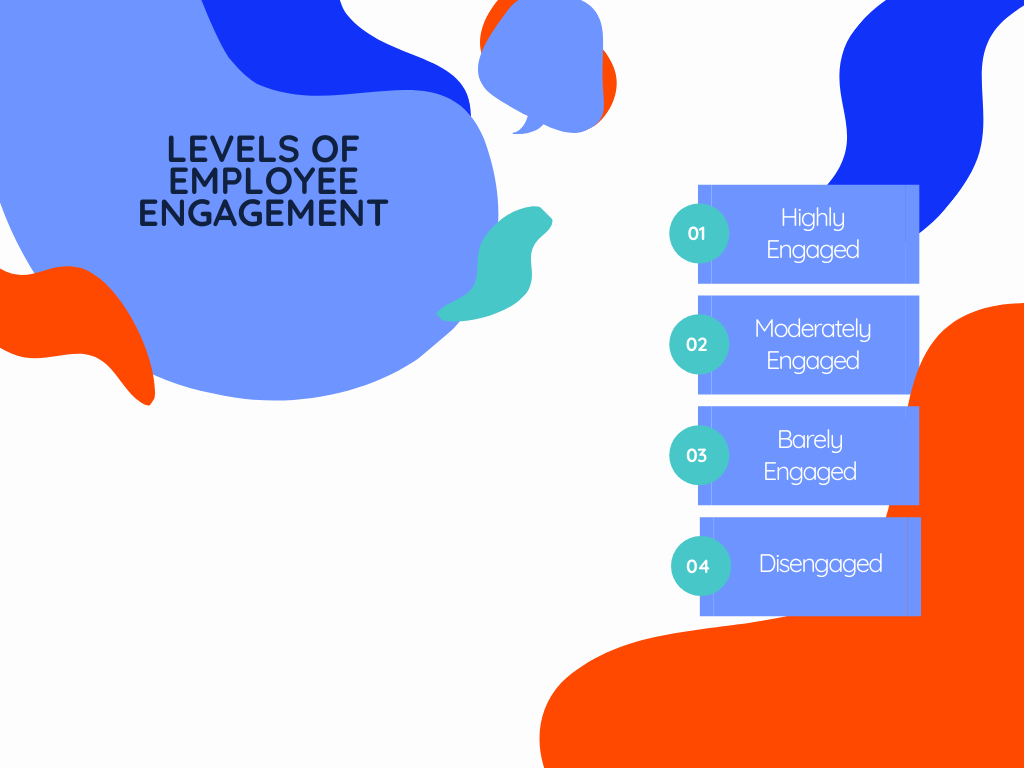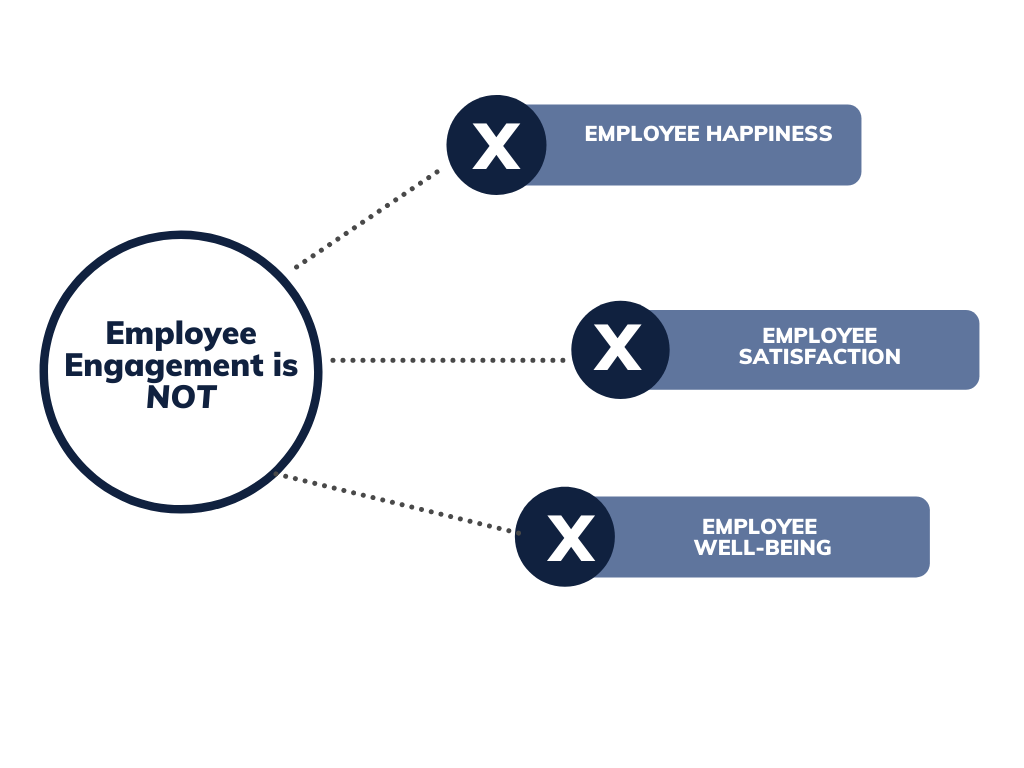What Is Employee Engagement (& How to Increase It in 2025)
Employee engagement is a critical part of a successful business marketing strategy.
Your employees are the rock stars of your organization. 🔥
(Mostly) everyone knows this.

92% of business executives agree that engaged employees are crucial to success.
Time spent investing in staff engagement is vital to your company’s growth.
So if you're goal is improving employee engagement — and decreasing the great resignation — let’s dive in and discover some employee engagement ideas you can implement today.
What is Employee Engagement?
Employee engagement refers to the level of physical, mental, and emotional investment one has for their job, workplace, teammates, management, and the business as a whole.
An engaged employee is deeply connected to the organization and the company's overall mission.
These workers also hold a clear vision of the company's direction that drives them to do a good job.
And it makes sense that higher employee engagement leads to better business outcomes — a 23% increase in profit, a 10% increase in customer loyalty, and 18% more sales productivity, according to a recent 2020 Gallup study.
Levels of Employee Engagement
Based on an employee's perception of their workplace, you will find four different levels of engagement.

Being aware of these employee engagement levels will help you shape your strategy to reengage employees who lack commitment and engagement with your business.
1. Highly Engaged Employees
Highly engaged employees are your best resources because they are clear about their thoughts, feelings, and attitudes regarding your company and its mission.
Engaged employees' positivity and love for their jobs make them invaluable assets
2. Moderately Engaged Employees
Moderately engaged employees somewhat align with the company’s objectives, but they can see room for improvement.
In addition, these employees don't go the extra mile in their jobs because they aren’t as committed — yet
3. Barely Engaged Employees
Barely engaged employees are just going through the motions — lacking any real motivation for their job.
These employees are just doing the bare minimum to earn a paycheck and are most at risk for high turnover.
4. Disengaged Employees
Disengaged employees have given up and have an opposing viewpoint of the company’s mission, goals, and future direction.
And unattached employees tend to be suspicious of management which can poison the waters for other employees if not addressed.
But Don’t Confuse Employee Engagement With...
Measuring employee engagement often appears in the same vein as happiness, satisfaction, or well-being categories.

So let’s dispel the overlap and be clear about what employee engagement isn’t.
Employee Happiness 👎
Happiness is not a great measure of employee engagement because it’s fleeting and highly subjective.
You cannot measure productivity by happiness because we all have good and bad days that have nothing to do with our degree of commitment.
Employee Satisfaction 👎
Employee satisfaction is a slippery slope because it doesn’t accurately predict the employee engagement level.
And in most instances, a satisfied employee will not be driven to go the extra mile because they may feel too content to grow beyond their current status.
Employee Well-Being 👎
Employee well-being can certainly increase engagement; however, it’s not the sole measurement that gauges commitment.
Instead, it’s a better indicator of a worker's ability to cope with stress, change, and the demands of their lives.
Benefits of Employee Engagement
The future success of your organization relies upon increased employee engagement.
Why? Because businesses that employ actively involved individuals see 21% higher profitability.
So let’s take a look at the benefits you can experience with an engaged workforce.
1. Increased Productivity
When an employee has a vested interest in their job's role in the company’s big picture, they are naturally more productive — equating to 17% more productivity than a disengaged employee.
2. Higher Retention Rate
Engaged employees are not the ones looking for jobs elsewhere.
These employees know their value in the organization, see growth opportunities, and roll with the changes because they understand the business's overall vision.
When employees feel a part of something bigger, they become more committed to staying and being a part of that movement, thus reducing employee turnover.
3. Happy Customers

Because engaged employees care about their organizations, they can’t help but spread that love through their customer service — representing a 10% increase in customer engagement and brand loyalty.
Increasing employee engagement leads to customer satisfaction and an overall better customer experience.
4. Less Missed Work
Employees who are consistently engaged have no problem showing up for their jobs — resulting in reduced absenteeism of 41%.
5. Improved Health
Engaged employees actively involved with their jobs typically enjoy healthy lifestyles that include exercise and eating more healthily.
As a result, you will see fewer minor mental health and chronic disease incidents because these employees invest time in self-care.
6. Fewer Workplace Injuries
A Gallup study shows that 70% fewer injuries occur in workplaces where employees are engaged because they are more focused and care about their work.

When an organization creates a culture based upon the quality of work, and their employees adopt that vision, you will naturally see a workplace culture that experiences fewer injuries.
What Drives Employee Engagement?
Now that we know the benefits of employee engagement, let’s focus on understanding the main drivers of worker participation.
Challenging Work
Opportunities to grow are born out of challenges and fuel mental toughness. If an employee’s work is not stimulating, it will create complacency allowing your workers the excuse to opt out of engagement.
Therefore, matching employees to their proper skill levels will be a task that gets the job done while allowing an engaged worker to contribute more significantly.
Passionate Leadership
Leadership that invests in building relationships and trust with employees increases engagement.
And is performance management that fosters workers’ growth — all necessary attributes that drive engaged staff.
Contribution to Business Success
Employees do best when they work for an organization with built-in steps to success.
Providing a clear path and vision of a worker's role keeps your employees motivated and committed.
Who’s Responsible For Employee Engagement?
Everyone needs to buy into the vision and mission to go beyond the norm.
How does that work?
First, you have to develop an engagement strategy that can become viral.
Any leadership position from the CEO, department heads, and human resources must “walk the talk.”
So let’s take a look at the responsibilities of these roles.
Leadership’s Role
Leadership’s role is to champion your employees and drive workers’ buy-in regarding the company culture.
Leadership that includes:
- Setting the tone for the employee’s environment
- Capturing the vision
- Communicating necessary changes
- Keeping the organization abreast of the business’s growth
HR’s Role
HR leaders are the glue that keeps the organization’s culture viable and holds teams accountable for executing a business’s vision.
HR professionals' roles include:
- Selecting and matching engaged employees to the proper jobs
- Driving processes and employee engagement tools for job enhancement
- Supporting and developing management
- Managing the day-to-day operations to focus the organization
Manager’s Role
Managers are in the trenches with your employees. They have a close relationship with workers allowing them to nurture an environment that encourages high employee engagement.
Managers' responsibilities include:
- Building relationships
- Holding a safe space to gather employee performance feedback and suggestions
- Employee recognition and team acknowledgment
- Providing performance reviews to allow for personal growth
- Conducting ongoing corporate training and compliance training
Employee’s Role
Employees are the eyes, ears, and mouth of your business.
As such, they possess invaluable input from your customers and are the direct line that connects you to your audience’s perception of the organization as a whole.
An employee’s role includes:
- Providing genuine, unbiased, and actionable comments
- Creating innovative solutions to problems
- Taking ownership of their performance and development
- Fostering meaningful relationships with staff and management
Employee Engagement Strategies
A study from Zenefits shows that it’s 63.3% harder for U.S. businesses with 50 to 500 employees to retain them versus hire them.
Businesses are starving for techniques and strategies to improve this ratio, so let’s take a look at employee engagement initiatives that work well to stave off low employee retention rates.
1. Start With Onboarding
Considering that 20% of employees typically leave a job in the first 45 days, you will see the immediacy of adopting an employee engagement strategy in the onboarding process for a new hire.
Start by employing the following tips:
- Show them how valuable they are from the day they start
- Help them understand the organization’s purpose and values
- Interact often and get to know employees on a personal level
- Establish regular one-to-one meetings
- Appreciate and recognize success no matter how small
- Utilize online training software
And when you engage employees from day one, you are getting them up to speed quicker, which adds tremendous value to your organization.
🤓Pro Tip! To really increase employee engagement, check out our top picks for employee engagement software!
2. Build Employee Engagement on Trust and Autonomy
No one likes to be micro-managed, as it indicates a lack of trust.
When you offer an employee experience that fosters autonomy on the job, it’s like you are saying, “Hey, I trust that you can do this and that you are ready.”
The nice thing about autonomy is its ability to create a level playing field that allows for personal ownership of work and leads to more job satisfaction.
3. Employ Effective Managers
When endeavoring to improve employee engagement, you must have a manager who can effectively inspire involvement.
In companies that fail to hire competent managers, we often see a subsequent increase in turnover.
And often, it’s not the manager’s fault that an employee leaves; instead, it’s the ability to coach employees that is missing.
So make sure that your managers possess a mentoring background.
4. Get to Know Your Employees
Getting to know your employees is not as simple as it sounds.
Workers thrive when management consistently communicates their importance and supports them instead of dismissing them as another cog in the wheel.
Keeping that in mind, be sure to set up one-to-one meetings that consistently allow you to check in with your employee's experience at a personal and business level.
5. Be Transparent About Company Culture
When you ask an employee to do something without an awareness of the big picture, it's difficult for them to feel plugged in and engaged.
Leadership must be transparent with company health and problems.
Excluding workers from vital internal communication conveys that employees aren’t important enough to be included in more significant organizational decisions — resulting in disengaged staff.
6. Show Appreciation for Your Employees
Foster a culture of gratitude by regularly acknowledging your team's hard work.
Utilize bonus cards for exceptional achievements or find employee appreciation gifts for personalized rewards.
This consistent appreciation not only uplifts morale but also solidifies employee commitment to your organization’s goals.
7. Give Employees a Forum for Feedback
A forum for employee feedback must be a two-way street.
Allowing your employees to have a voice and listening to them is essential.
You can conduct an employee engagement survey or send out questionnaires periodically that gather information in a non-biased way.
And then offer constructive feedback allowing your employees to know that you’ve heard them and that their input is valuable.
8. Nurture (Remote) Community Spirit
Fostering a sense of community through team-building events is vital.
The tricky part is building community spirit with a growing digital remote workforce.
One way is to offer Virtual Happy Hours, which are social events that utilize an employee engagement platform such as Zoom or Google Meets.
They create community by implementing activities like Trivia, MTV-Cribs, Something in Common IceBreakers, and reinvented Bingo.
9. Communicate Company Goals and Core Values
Communicating your company's goals and core values is a top-down strategy involving all your leadership.
And the upper management stewarding your organization must live and breathe the culture they ask their staff to adopt.
You lose all credibility with employees when you do not consistently communicate how every aspect of the business is an extension of its ethics and foundation.
10. Acknowledge Great Work
66% of employees say they would quit their jobs if their work were not recognized.
Unfortunately, recognition by management may not be enough to inspire employee motivation, let alone engage them.
And this is where recognition programs that offer a peer-to-peer employee survey help.
How others see each other in an organization carries a lot of weight and can be that next meaningful layer of feedback that influences engagement.
11. Prioritize Employee Well-Being

Due to the shift towards working from home, we now see a new kind of burnout and overwhelm caused by the ever-increasing connectivity of a digital world that knows your every move.
Offering health and wellness opportunities to both frontline employees and remote employees is a fantastic way to show your staff that you care about their well-being.
And when workers feel that you care, that goodwill translates to higher morale and employee empowerment.
12. Offer Advanced Training and Continuing Education
In a report issued by Gallup called State of The American Workplace, 87% of millennials find that professional or career growth opportunities are essential.
Offering deliberate paths to growth and advancement keeps employees striving to become more valuable to the company and themselves.
Providing reimbursement programs for approved continuing education and training opportunities tells your staff that you care about their growth — resulting in a win-win for both parties.
13. Implement a Regular Feedback System
Feedback offered inconsistently is something that can backfire on you.
Why? Because it often shows up concerning something that is not working.
When employees experience only problematic employee communication, it can sour them in their jobs.
By offering timely feedback on various topics that work and sometimes don’t, you will find that an employee's experience is more comfortable with solicited and unsolicited evaluations.
14. Offer Extra Incentives and Perks
Offering extra incentives and perks makes it evident that you value your employees.

Incentives and perks include:
- Home loaning and home office reimbursement
- Continuing education stipends
- Commuter allowances
- Gym memberships
- Profit-sharing
- Visa support for spouses
- Immigration services
The simple act of offering an employee experience that includes a yoga membership or a discount on a meditation retreat says you care about their mental, emotional, and physical health — thus leading to lower stress levels and higher engagement.
How Employee Engagement is Your Key to Success
Fun fact: the costs associated with accommodating actively disengaged employees is about $450-$550 billion each year.
Embracing your workers' impact on your bottom line is no longer a luxury.
Investing in an effective employee engagement strategy is essential to producing a thriving business.
It’s time to embrace employee advocacy and improve employee engagement.
A certified content marketer with Smart Blogger, Kris Freeman, knows how to please the ‘Google Gods’ so that your content gets noticed, is cool to read, and starts to rank in Google. As a business owner, Kris has seen firsthand how mediocre businesses become unstoppable pursuits when Google starts to consider you relevant. You can find more of Kris's work at kriscfreeman.com or at her personal blog.